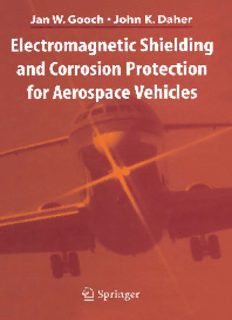
Electromagnetic Shielding and Corrosion Protection for Aerospace Vehicles PDF
Preview Electromagnetic Shielding and Corrosion Protection for Aerospace Vehicles
Jan W. Gooch John K. Daher Electromagnetic Shielding and Corrosion Protection for Aerospace Vehicles ~ Springer JanW.Gooch JohnK.Daher GeorgiaInstituteofTechnology,Atlanta GeorgiaInstituteofTechnology,Atlanta 2020HowellMillRoad 3028GantQuartersCircle Atlanta,GA30318 Marietta,GA30068 USA USA Email:[email protected] Email:[email protected] LibraryofCongressControlNumber:2006938807 ISBN-IO:0-387-46094-2 e-ISBN-IO:0-387-46096-9 ISBN-13:978-0-387-46094-9 e-ISBN-13:978-0-387-46096-3 Printedonacid-freepaper. ©2007 SpringerScience+BusinessMedia,LLC Allrightsreserved.Thisworkmaynotbetranslatedorcopiedinwholeorinpartwithoutthewrittenpermis- sionofthepublisher(SpringerScience+BusinessMedia, LLC, 233SpringStreet, NewYork,NY 10013, USA), exceptforbriefexcerptsinconnectionwithreviews orscholarlyanalysis.Useinconnectionwith anyform of informationstorageandretrieval, electronicadaptation,computersoftware,orbysimilaror dissimilarmethodologynowknown orhereafterdevelopedisforbidden. The useinthispublicationoftrade names, trademarks,servicemarks, andsimilarterms, even iftheyare notidentifiedassuch, isnottobetakenasanexpressionofopinionastowhetherornottheyaresubject toproprietaryrights. 9 8 7 6 5 432 I springer.com Contents Preface ix Acknowledgment xi 1. ElectromagneticShieldingEffectivenessand CorrosionPrevention 1 1.1 Electromagnetic Environment. 1 1.2 Importance ofElectromagnetic ShieldingandCorrosion Prevention forAircraft 1 2. FundamentalsofCorrosion 5 2.1 Corrosion 5 2.2 Conditions forCorrosion 6 2.2.1 Electrochemical Aspects 6 2.2.2 EnvironmentalAspects 8 2.2.3 MetallurgicalAspects 10 2.3 TypesofCorrosion 11 2.3.1 UniformAttack 11 2.3.2 GalvanicorTwo-MetalCorrosion 12 2.3.3 CreviceCorrosion 12 2.3.4 Pitting 13 2.3.5 IntergranularCorrosion 14 2.3.6 SelectiveLeaching 14 2.3.7. ErosionCorrosion 14 2.3.8 StressCorrosion 14 3. FundamentalsofElectromagneticShielding 17 3.1 DefinitionofShieldingEffectiveness 17 3.2 FactorsthatDetermine ShieldingEffectiveness 17 3.3 Electromagnetic ShieldingTheory 18 3.3.1 Absorption Loss 18 vi Contents 3.3.2 ReflectionLoss 20 3.3.3 MultipleReflection CorrectionTerm 21 3.3.4 EffectofNear-Field SourcesonShieldingEffectiveness 21 3.4 PracticalElectromagnetic Shielding 22 3.5 RoleofConductive SealantsinElectromagnetic Shielding 24 4. Investigationofthe RelationshipBetweenDC Resistanceand ShieldingEffectiveness..•.•..................................................................................25 4.1 Determining aRelationship BetweenDCResistanceandShielding Effectiveness 25 4.2 StainlessSteelTestJointforDCResistanceandShielding Effectiveness Measurements 25 4.3 DCResistanceMeasurements 28 4.4 ShieldingEffectiveness Measurements 29 4.5 Measurement ResultsontheRelationship Between DCResistance andShieldingEffectiveness 30 4.6 EffectofPlateSeparationonShieldingEffectiveness 33 5. IdentificationandEvaluationofOptimumConductiveSealant Materials 35 5.1 Identification ofMaterials 35 5.2 Evaluation ofConductive SealantsinSaltSprayEnvironmentper ASTMB117 38 5.2.1 Aluminum TestJoints 38 5.2.2 Measurement ResultsofDCResistanceVersus SaltSpray Exposure 42 5.2.3 Measurement Results ofShieldingEffectiveness Versus SaltSprayExposure 43 5.3 SummaryofOptimum Conductive SealantMaterials 46 5.4 Relationship BetweenDCResistance, ShieldingEffectiveness, and Transfer Impedance 46 5.4.1 Evaluation ofLaboratory SealantTestSamples 46 6. Field TestEvaluationson E-3A Aircraft 57 6.1 Introduction 57 6.1.2 VisitstoAirForceInstallations 58 6.2 FieldTestDescription 63 6.2.1 LocationofTestSites 63 6.2.2 FieldTestMethods 63 6.2.3E-3AAircraft FieldTestResults 72 6.3 Conclusions 73 6.4 Recommendations 74 Contents vii 7 AssessmentoftheValidityofthe MIL-B-50878Class R Bonding Requirements 75 7.1 Background 75 7.2 BasislRational Behindthe2.5-Milliohm BondingRequirements 76 7.3 SummaryandConclusionsonValidityof2.5 MilliohmBonding Requirements 78 7.4 ProposedChanges toStandards,SpecificationandHandbooks 78 7.4.1 Modifications toMIL-B-5087B 80 7.4.2 Modifications toMIL-STD-188-124A 82 7.4.3 Modifications toMIL-STD-1541 85 7.4.4 Modifications toMIL-STD-1542 86 7.4.5 Modifications toMIL-STD-454K 87 7.4.6 Modifications toMIL-HDBK-253 88 7.4.7 Modifications toAFSCDesignHandbook 1-4 91 7.4.8 Modifications toNATO STANAGNo.3659 97 7.5 Recommendations forCorrosion PreventionMaterials/Processes forUseonExisting(andFuture)AircraftandWeaponSystems 99 7.6 Recommendations forUsingCorrosion PreventionMaterials for retrofitting ExistingNuclear HardenAircraftandWeapons Systems 99 7.6.1 RetrofittingAircraftwithConductive Sealant 99 7.6.2. Annodized andChemicalConversion TypeTreated Aluminum Surfaces 99 7.7 Resealable JointsUsingLiquidAppliedConductive Sealantsl00 7.7.1 ResealableJointsinSaltSprayChamber. 100 7.7.2 OpeningResealableJoints 101 7.7.3 Comments 101 7.8 ShieldingEffectiveness ofNon-Conductive CorrosionInhibitive Sealant 101 7.9 Aerospace Material Specification 102 8. EMIGaskets 103 8.1 EMIGasketApplications andSelectionCriteria 103 8.2 StampedandFormedMetalGaskets 103 8.3 WireMeshGaskets 104 8.4 Conductively-LoadedElastomericGaskets 105 8.5 Conductive Fabric-CladFoamGaskets 105 8.6 ConductiveGelGaskets 106 viii Contents A. ShieldingEffectivenessDatafor Test Jointswith Varying Resistances..........•..............................................................................................107 B. ShieldingEffectivenessVersusPlateSeparationData.....•............................117 References.....•.•......••..•.•......................•.........................••.......•........•........................123 Index.••.•••........•.•.....•.......•...•.......................•...............•..............•........................•....•125 Preface The new generation ofcivil aircraft depends heavily onelectronic systems to imple- ment safety-critical functions. Because these aircraft may be exposed to high inten- sity radiated fields (HIRF) created by radio frequency (RF) emitters based on the ground, in the air, and at sea, civil aviation authorities have become increasingly concerned about thepotential forelectromagnetic interference (EMI) tothese critical electronic systems. With the increasing density ofthe electromagnetic environment, civilian aircraft authorities and standards committees have developed HIRF require- mentsthatarebeing applied tocivilaircraft certification programs. Military aircraft and weapon systems must operate compatibly within an elec- tromagnetic environmentthat can be even more severe than the civil HIRF environ- ment. For example, the electric fields from a high altitude, nuclear electromagnetic pulse (EMP) can reach a peak amplitude of 50,000 Vim. Emerging high power microwave (HPM) threats can generate power densities in excess of 100W/cm2 at tactical ranges. And aircraft that must take offfrom and land on naval ships can be exposed to a dense and highly intense electromagnetic environment with electric fieldstrengths exceeding 1000V1m. Military and commercial aircraft are assembled with many fasteners such as screws and bolts to secure airframes, skin and other bonded joints. Thejoints must be conductive or shielding effectiveness will not be optimized. Conductive and cor- rosion resistant materials such as sealants and gaskets are required to maintain con- ductivity along the entire structure ofthe aircraft under flight and ground environ- mental conditions including moisture, rain, and pollution from the atmosphere. The conductivity ofcorrosion resistant sealant materials must be monitored under accel- erated weathering conditions to determine the conductivity over an 'extrapolated period oftime to simulate an acceptable life ofthe sealant between scheduled main- tenance periods. Comprehensive studies that provided understanding of shielding effectiveness s as related to conductivity, and the relationship ofmaterial chemistry to conductivity and corrosion were performed toprovide fundamental understanding ofthesephenomena, andfinally, optimized shielding effectiveness foraircraft. x Preface Significant progress was made in the identification and, ultimately, optimization ofcorrosion prevention materials and/or processes. These materials are capable of protecting metal surfaces from air/moisture corrosion overaspecified period oftime. Inaddition, electricallyconductivecorrosion preventionmaterials thatarecapable of maintaining EMI/EMP protection of aircraft and weapon systems were identified. With these capabilities, existing aircraft and weapon systems can now be protected from further corrosion, and existing nuclear-hardened weapon systems can be retro- fitted with corrosion prevention. From these efforts, American Materials Standard, AMS 3262,waspreparedfortheuserofconductive siliconerubber-basedsealant. Acknowledgment The authors wish to acknowledge David Ellicks and Eugene Bishop ofthe War- ner Robins Air Logistics Center, U. S.Air Force, fortheir significant contributionto the research and development projects that provided information for this book, and for their continued interest in electromagnetic shielding and corrosion prevention to provide a safer operating environment and maximum operating lifetime for aircraft. In addition, the authors wish to express their gratitude to the Society ofAutomotive Engineers (G9 Committee) for their cooperation during the preparation, acceptance and publication of American Materials Standard, AMS 3262, SEALING COMPOUND, SILICONE RUBBER, TWO-PART, ELECTRICALLY CONDUCTIVEANDCORROSIONRESISTANT, FORUSEFROM -67 to 500 of (-55 to 260°C). AMS 3262 was a product ofthe information generated from the projects discussed inthisbook.
Description: